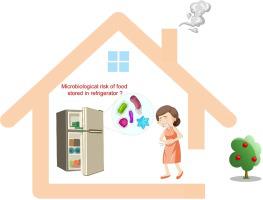Environment International ( IF 11.8 ) Pub Date : 2022-11-17 , DOI: 10.1016/j.envint.2022.107647 Wenfang Lin 1 , Fei Xu 2 , Hongqin Guo 3 , Li Cui 1

|
Domestic refrigerator is a widely used appliance to keep food fresh and retard food spoilage in household. However, our understanding of microbial health risk associated with food under such circumstance still remains very poor. Here, typical types of food (vegetable, fish, and pork) were kept in a domestic refrigerator at 4 °C for 3–30 days. Temporal dynamics of antibiotic resistome, pathogens, bacterial and fungal communities during this period were investigated via high-throughput quantification and Illumina sequencing technologies. Results showed that a large number (21–134) of antibiotic resistance genes (ARGs) and mobile genetic elements (MGEs) were detected across the three food types, including 10.06 % of high-risk ARGs classified by their risk ranks. Moreover, four bacterial pathogens (i.e., Bacillus cereus, Cronobacter spp., Klebsiella pneumoniae and Staphylococcus aureus) targeted by marker genes including the pathogen-specific genes or virulence factor genes, and some potential fungal pathogens (e.g., Fusarium, Candida, and Aspergillus) were detected, indicating the occurrence of microbial risk even at the normally regarded safe storage temperature. Among all food types, the total bacterial density and ARG abundances in fish rapidly increased after only 3 days, much faster than vegetable and pork after 10 days. In addition, fish samples contained the highest ARG and pathogen abundances, indicating its potentially higher health risk than other food types. Finally, the shifts of ARG pattern were mainly contributed by bacterial communities and MGEs. This study highlights that food preserved in refrigerator at 4 °C could still be an unneglected microbial risk, and raises awareness of improving food safety in domestic environment.
中文翻译:

家用冰箱:一个被忽视的抗生素抗性基因和病原体滋生地
家用冰箱是家庭中广泛使用的保鲜、延缓食物变质的器具。然而,我们对在这种情况下与食品相关的微生物健康风险的了解仍然很差。在这里,典型类型的食物(蔬菜、鱼和猪肉)在 4 °C 的家用冰箱中保存 3-30 天。通过高通量定量和 Illumina 测序技术研究了这一时期抗生素耐药组、病原体、细菌和真菌群落的时间动态。结果表明,在三种食物类型中检测到大量 (21–134) 抗生素抗性基因 (ARG) 和移动遗传元件 (MGE),其中包括 10.06% 按风险等级分类的高风险 ARG。此外,四种细菌病原体(即蜡样芽孢杆菌、克罗诺杆菌属、检测到被包括病原体特异性基因或毒力因子基因在内的标记基因靶向的肺炎克雷伯菌和金黄色葡萄球菌,以及一些潜在的真菌病原体(例如镰刀菌、念珠菌和曲霉菌),表明即使在通常认为的微生物风险发生安全储存温度。在所有食物类型中,鱼类的总细菌密度和 ARG 丰度仅在 3 天后迅速增加,比蔬菜和猪肉在 10 天后增加得更快。此外,鱼类样本中含有最高的 ARG 和病原体丰度,表明其潜在的健康风险高于其他食物类型。最后,ARG 模式的变化主要由细菌群落和 MGEs 贡献。这项研究强调,在 4 °C 的冰箱中保存的食物仍然可能是一种不可忽视的微生物风险,


























 京公网安备 11010802027423号
京公网安备 11010802027423号